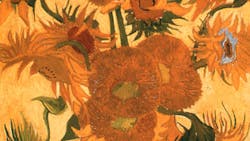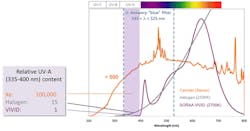Like van Gogh’s “Sunflowers”?
What if museum lighting were destroying them? What if your invention had enabled the lights that were doing the damage?
Last week, I received a curious press release from Soraa, The GaN-on-GaN LED company founded by Shuji Nakamura, the guy who invented a way to make blue and UV LEDs, which is the reason we can have high brightness (HB) white LEDs. (The part of the spectral gamut that produces HB white light comes from “yellow” phosphors on the inside surface of the LED package.)
The release is passionate, insisting that there is no evidence that white LEDs cause pigment degradation and pointing out that the experiments that have been referenced did not use white or any other color) LEDs. I’ll quote the release at the end of the article, with a diagram that compares the spectral content of light sources.
So I asked myself, where did this come from? A little Googling turned up four dozen or so articles from the fine arts of popular press.
The primary source seems to be this one, in The Independent, a British cultural publication. The tile is: “Sunflowers wilt: Van Gogh's masterpiece is slowly turning brown as a result of exposure to LED lighting”
The gist is that some wavelengths of light accelerate the oxidation of certain chromium compounds that are part of the yellow pigments that van Gogh and other artists used. The piece goes on to say that photons from LEDs do the greatest damage.
Related Articles
• Understanding LED Application Theory And Practice
• High Brightness Displays Take On Challenging Apps
• Fundamentals of LED Light Pipes
The first claim is supported by a series of scientific articles in Analytical Chemistry, a journal of the American Chemical Society. The most recent was published last October. The second is not supported by anything in the fourth paper, which is he one that describes experiments with a real (Xenon) light source.
The Analytical Chemistry articles share a common title: “Degradation Process of Lead Chromate in Paintings by Vincent van Gogh Studied by Means of Synchrotron X-ray Spectromicroscopy and Related Methods.” []
The abstract for the most recent paper says, in part: “The darkening of the original yellow areas painted with the chrome yellow pigment . . .is a phenomenon widely observed on several paintings by Vincent van Gogh, such as the famous different versions of Sunflowers. During our previous investigations on artificially aged model samples of lead chromate, we established . . . that darkening of chrome yellow is caused by reduction of PbCrO4 to Cr2O3·2H2O (viridian green), likely accompanied by the presence of another Cr(III) compound. . . .
“In the second part of this work, in order to demonstrate that this reduction phenomenon effectively takes place in real paintings, we study original paint samples from two paintings of V. van Gogh. . . .
[The article goes on to say that they employed] “high lateral resolution spectroscopic methods . . . [that used] synchrotron radiation (SR), such as microscopic X-ray absorption near edge (μ-XANES) and X-ray fluorescence spectrometry (μ-XRF. . . .
“Additionally, μ-Raman and mid-FTIR analyses were carried out. . . . On both paint microsamples, the local presence of reduced Cr was demonstrated by . . μ-XANES point measurements. The presence of Cr(III) was revealed in specific areas, in some cases correlated to the presence of Ba(sulfate) and/or to that of aluminum silicate compounds.”
ESERF
XANES refers to ESERF, The European Synchrotron Radiation Facility in Grenoble, France. ESERF’s Web page says: “Imagine a source of X-rays 10,000 billion times brighter than a hospital X-ray machine. This brilliant source is called a synchrotron, and the X-rays it produces reveal the structure of matter in all its beauty – and complexity.”
Okay, that’s written for a broad audience, but you get the idea. They used this amazing synchrotron, but what did they actually do? Where does the LED illumination come in? (In fact it doesn’t.)
For $35, the ACS will let civilians like me read Analytical Chemistry papers. Or, one can download them and read them for 48 hours before they disappear.
I paid the freight and downloaded that October paper.
The relevant paragraph says:
“UVA-Visible Light Exposure. All paint models have been aged for 800 h, employing a SOLARBOX 1500e System (CO.FO.ME.GRA, Milano, Italy.) This chamber is equipped with a xenon lamp (550 W/m2) emitting between 290 and 800 nm (UVA-visible light) and operating at a temperature between 50 and 60 (degrees) C. A soda-lime glass UV filter between the light source and the samples allows simulating exposure to indoor light conditions.”
That’s it. Just a reference to a spectral band obtained from a xenon lamp.
Where did a dozen publications get the LED story?
The ESERF site has a press release: “LED lights may be bad for Van Gogh paintings. []
The deck says: “Dozens of masterpieces are susceptible to light induced darkening of yellow areas.”
The body copy goes on: “An international team of scientists has used synchrotron X-rays to better understand why some bright yellow colours in Vincent Van Gogh’s paintings are turning brown with time, while others do not. The research focus was on chrome yellow, a colour favoured by Van Gogh to depict sunshine and light. Several types of this yellow were found to be very sensitive to green and blue light which causes a darkening of the painting. The scientists recommend that museums identify all paintings with this type of chrome yellow and protect them in particular from the increasingly popular LED lights which emit a large amount of blue.”
Oh? But that latter assertion isn’t in the paper.
Where does that assertion come from?
The Independent attributes it to the man who runs the synchrotron:
“Claus Habfast, from the European Synchrotron Radiation Facility in France, where some of the artworks were studied, said: "LED lights appear to have many advantages but museums should carefully consider that paintings from the Van Gogh era could be affected by them.
"Paintings that have moderate darkening will find this accelerates in the coming years.
"Of course, it's not advisable to put these paintings in the dark because they are part of the cultural heritage of humankind and the public wants to see them. But museums have to strike the right balance," he says.
Since the January 13 date The Independent (apparently) broke the story until the search I just performed (7 days later), those quotes were picked up no fewer than 50 times, according to Google.
And I’m probably the first journalist to cough up the 35 bucks to read the actual paper.
SORAA’S TAKE
By now, you probably want to know what the release that started my research said. (It’s Soraa’s release; it doesn’t quote Mr. Nakamura himself.) Here:
“The degradation studies [Monico et al., Anal. Chem., 2013, 85 (2), pp 860–867] in fact employed a high-intensity Xenon lamp (Cermax 175W) as the photo-excitation source. Xenon lamp spectra are vastly different than those of white-emitting LEDs for illumination, with the Xenon lamp including significant amounts of ultraviolet (UV) light in the UV-A, UV-B, and UV-C wavelength regimes. Degradation was observed under intense (more than 1000x conventional illumination) irradiation when the Xenon lamp was used in conjunction with a so-called “blue” filter passing wavelengths between 335 nm (UV-A) and 525 nm (green), which is in fact about five times broader than the blue wavelength regime. Degradation was more pronounced when a UV filter (240-400 nm) was used, or with no filter at all.
“Photo-oxidation effects are more probable as excitation wavelength gets shorter and it is very plausible that the degradation observed by the researchers at University of Antwerp is caused by UV-A light leaking through the “blue” filter they employed. In contrast, LEDs (including SORAA VIVID LED MR16 2700K, for example) emit essentially no UV-A emission – more than 100,000x less than the filtered Xenon lamp used in the University of Antwerp studies (see chart below).
The sunflowers in the Louvre may be getting browner, but it has not yet been demonstrated that it’s the fault of HB LEDs.
About the Author
Don Tuite Blog
Don Tuite covers Analog and Power issues for Electronic Design’s magazine and website. He has a BSEE and an M.S in Technical Communication, and has worked for companies in aerospace, broadcasting, test equipment, semiconductors, publishing, and media relations, focusing on developing insights that link technology, business, and communications. Don is also a ham radio operator (NR7X), private pilot, and motorcycle rider, and he’s not half bad on the 5-string banjo.

